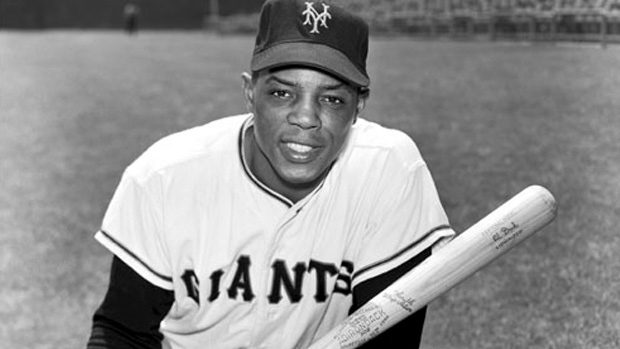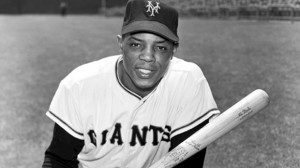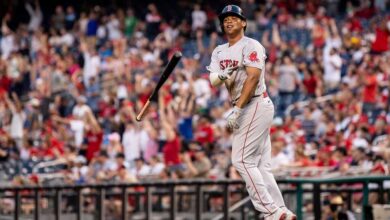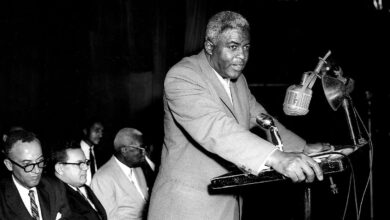

There is not much to debate here about Willie Mays, but less is known about his American League counterpart. While he questionably beat out the White Sox’ Minnie Minoso for Rookie of the Year, Gil McDougald had a fine 10-year career for the New York Yankees, winning five World Series championships in the Bronx. He is the first of eight ROTY to wear pinstripes. McDougald was also a six-time All-Star and a versatile player who could play the entire infield with the exception of first base. These rookies would face each other in the 1951 Fall Classic.
Follow along in the series and get caught up by reading: 1950 Rookie Battle 1949 Rookie Battle
Ready? Let’s do this.
American League: INF Gil McDougald, New York Yankees
McDougald was 23 as a rookie from San Francisco. After attending the University of San Francisco, he signed a contract with the Yankees prior to the 1948 season. He played well in his three years in the minors, playing for Twins Falls (Class C), Victoria (Class B), and Beaumont (double-A), and showed he could hit for both average (.340) and power (42 home runs).
When McDougald broke in with New York in 1951, Joe DiMaggio was in his last season and Mickey Mantle was in his first; a rookie like McDougald. Although both Mantle and McDougald finished with similar numbers in regards to home runs and RBIs (Mantle hit 13 home runs with 65 RBIs, while McDougald hit 14 home runs with 63 RBIs), the fact is McDougald had a better all-around rookie season. His slash line (.306/.396/.488) is a bit better than Mantle’s (.267/.396/.488).
McDougald’s versatility was also huge asset for manager Casey Stengel — he played 82 games at third and 55 games at second. In 1951, he had a .981 fielding percentage at second base. On May 3, 1951, McDougald tied a then-American League record for RBIs in an inning with six (Fernando Tatis currently holds the Major League record with eight after hitting two grand slams, while Alex Rodriguez holds the American League record with seven). In that ninth inning versus the St. Louis Browns, he hit a grand slam and a triple.

In his first of eight World Series appearances, he became the first rookie to hit a grand slam in the Fall Classic. The home run came in game five versus the New York Giants at the Polo Grounds. McDougald’s .306 regular-season average led the club, and he finished ninth in 1951 MVP voting. Minoso was more of a threat for ROTY than Mantle. The first African-American to ever play for the Chicago White Sox, Minoso captured 11 first-place votes to McDougald’s 13. In 146 games between Cleveland and Chicago, Minoso hit .326/. 422/.500. His batting average was second in the American League and he led the majors in triples with 14. Minoso was fourth in MVP voting.
McDougald made the American League All-Star team for four consecutive years between 1956 and 1959. Though he is perhaps is best remembered for, or rather forever linked with 1955 Rookie of the Year Herb Score. In 1957, McDougald hit a sharp line drive off the eye of the Cleveland Indian southpaw. It hastened an early ending to what may have been a promising career for Score.
In his last World Series appearance in 1960, McDougald scored the tying run in the ninth inning of game seven between the Yankees and the Pirates. The tie was short lived, however, as Bill Mazeroski hit his famous World Series-clinching walk-off homer in the bottom of the inning. He finished his career hitting .276 with 112 home-runs and 576 RBIs.
National League: CF, Willie Mays, New York Giants
Mays is often in the discussion for the all-time best ballplayer. He is inarguably regarded as the consummate five-tool player. Mays was a 24-time All-Star, two-time MVP, and winner of 12 Gold Glove awards. He could do it all: hit (lifetime .302/.384/.557), hit for power (660 home runs; fourth all-time behind Bonds, Aaron, and Ruth), run (338 steals, first player ever to steal 300 bases and hit 300 home runs), play defense and throw (a career .981 fielding percentage, with 195 outfield assists). His 7,095 outfield putouts remain a major-league record. He is also 10th all-time in career hits with 3,283. Finally, lest we forget to mention it here, there was “The Catch.”
Growing up in segregated Westfield, Alabama, athletics was in Mays’ genes. His father, who was named after President William Howard Taft, played ball for a Negro team at his steel mill, while his Mother played basketball and was a sprinter in track and field.
There was no baseball team at Fairfield Industrial High School, so Mays had no choice but to play basketball and football. He excelled at both, averaging 20 points per game in basketball, and was a star quarterback in football. Meanwhile, at just 14 years old, he played baseball in semi-pro & amateur leagues, including a steel-mill team with his father.
Opting for baseball, he started his professional career the same year Jackie Robinson broke baseball’s color barrier, 1947. After briefly playing for the Negro minor league Tennessee Chattanooga Choo-Choos, he became an outfielder for the Birmingham Black Barons. He was signed out of high school by the Giants, playing well at every level in the minors, including Class B Trenton and triple-A Minneapolis. He joined the big league club on May 25, 1951, and immediately was put into center field.
After going hitless in his first 12 at-bats, Mays’ first major-league hit was a home run. To the delight of the New York fans at the Polo Grounds, his shot off future Hall of Famer and Brave Warren Spahn landed over the left-field roof.
Mays made one of his most spectacular catches as rookie. It was at Forbes Field, where he made a racing one hand grab off the bat of the Bucs’ Rocky Nelson. The ball was scorched to the deepest part of the park, and Willie made a bare-hand grab looking over his shoulder. The Giants went on to win the National League pennant in 1951, only to lose to McDougald’s Yankees in six games.
Following a two-year stint in the Army, Willie returned in 1954 to once again help his team win the pennant and reach the World Series. It was in game one of the ’51 World Series versus the Indians, where he made his famous grab. “The Catch” was made off the bat of Cleveland’s Vic Wertz. Mays kept going further back and back towards the wall, finally hauling the ball in his glove as though he was a wide receiver in football. The play preserved a 2-2 tie and the Giants went on to sweep the Indians — who had 111 regular-season wins that season — in four straight.
In 1957, Mays won the first of 12 consecutive Gold Glove awards. He also proved to be quite resilient, as he played in at least 150 games for 13 consecutive seasons (1954-1966). His Giants, now in San Francisco, won the 1962 National League pennant only to lose in seven games to the New York Yankees.
Mays’ last hurrah came in his return to New York as member of the Mets. His year-and-a-half stint culminated with an appearance in the 1973 World Series versus the Oakland A’s. Although he only had seven at-bats, he did get the first hit of the series in game one.
Inducted into the Hall of Fame in his first year of eligibility in 1979, Mays is the sixth all-time leading vote getter for admittance to Cooperstown. Remarkably, he fell just short of 95% of the vote, getting 94.68% by the Baseball Writers Association.
As a reminder, the scoring system for the Rookie of the Year battle is three points for the best rookie year, five points for the best career.
Rookie of the year goes to … Mays.
The rookie numbers are similar: Mays hit .274/.356/.472, with 20 home runs and 68 runs batted in, while McDougald hit .306/.396/.488, with 14 home runs and 63 RBIs. As good as McDougald’s statistics were, he served in a more reserve utility role.
Mays, on the other hand, almost single handedly led his team to the World Series. Most importantly, he had all the intangibles, something more than any ballplayer, much less McDougald, could ever possess. Three points for Mays.
Rookie career goes to … Mays. He is a legendary icon of the game. While Yankees fans may remember McDougald, most casual baseball fans may not. Five points for Mays.
So, our overall score after three seasons (1949-1951): NL 16, AL 8
Next up for 1952: Joe Black of the Brooklyn Dodgers vs. Harry Byrd of the Philadelphia Athletics.




